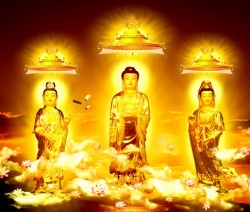Śrīmālādevī Siṃhanāda Sūtra
The Śrīmālādevī Siṃhanāda Sūtra (Sanskrit; traditional Chinese: 勝鬘師子吼一乘大方便方廣經; pinyin: shèngmán shīzihǒu yīchéng dàfāngbiàn fāngguǎng jīng; Japanese: 勝鬘経 Shōman-kyō) is one of the main early Mahāyāna Buddhist texts that teaches the doctrines of Tathāgatagarbha and the One Vehicle (Skt. ekayāna), through the words of the Indian queen Śrīmālā. After its composition, this text became the primary scriptural advocate in India for the universal potentiality of Buddhahood.
History
Brian Edward Brown, a specialist in Tathāgatagarbha doctrines, writes that it has been determined that the composition of the Śrīmālādevī Siṃhanāda Sūtra occurred during the Īkṣvāku Dynasty in the 3rd century CE, as a product of the Mahāsāṃghikas of the Āndhra region (i.e. the Caitika schools). Wayman has outlined eleven points of complete agreement between the Mahāsāṃghikas and the Śrīmālā, along with four major arguments for this association. Sree Padma and Anthony Barber also associate the earlier development of the Tathāgatagarbha Sūtra with the Mahāsāṃghikas, and conclude that the Mahāsāṃghikas of the Āndhra region were responsible for the inception of the Tathāgatagarbha doctrine.
Translations
The Śrīmālādevī Siṃhanāda Sūtra was translated to Chinese in 436 CE by Guṇabhadra (394-468). A complete Sanskrit original is no longer extant, but extensive quotations are found in the Sanskrit text of the Ratnagotravibhāga as well as some recently discovered fragments conserved in the Schøyen Collection. It was later translated into English by Alex and Hideko Wayman as The Lion's Roar of Queen Srimala.
Content
The Śrīmālādevī Siṃhanāda Sūtra teaches the reality of an ultimate, immaculate Consciousness within each living being, which is the Buddhic "Dharmakāya" (essence of Truth), which is yet temporarily sheathed in obscuring defilement. This Dharmakāya, when viewed as intrinsically free from spiritual ignorance, is said to constitute Eternity, Bliss, the Self, and Purity in their perfect state. The use of the word "Self" in this sutra is in a way unique to this class of sutra (see: Ātman in Buddhism). The great Queen Śrīmālā, who according to this text is empowered by the Buddha to teach the Dharma, affirms: "... the Dharmakāya of the Buddha has the perfection of permanence, the perfection of pleasure, the perfection of Self, the perfection of purity. Whatever sentient beings see the Dharmakāya of the Tathagāta that way, see correctly. Whoever see correctly are called the sons of the Lord born from his heart, born from his mouth, born from the Dharma, who behave as manifestation of Dharma and as heirs of Dharma."
The scripture, which was extremely influentially by way of clarification of the Tathagātagarbha-Buddhist view of Śūnyatā (Emptiness), insists that the ultimately correct understanding of Emptiness is that the Tathāgatagarbha is empty of all knowledge that is not Liberation, whereas, in contrast, the qualities which characterize a Buddha are not empty of inconceivable virtues. An alternative title offered by the Buddha for this sutra expresses this idea of an ultimate meaning to the Emptiness doctrine: "The True Revelation of the Buddha's Intention when Teaching Emptiness."
The sūtra has, furthermore, significantly contributed to the Mahāyāna notion of the permanent, steadfast and eternal Tathagātagarbha, which is nothing less than the perfect Dharmakāya temporarily concealed by (ultimately unreal) mental contaminants.
There is some debate as to whether or not the Tathagātagarbha constitutes true self or not, although that perfect Self is nowhere denied in the sutra, but affirmed.
